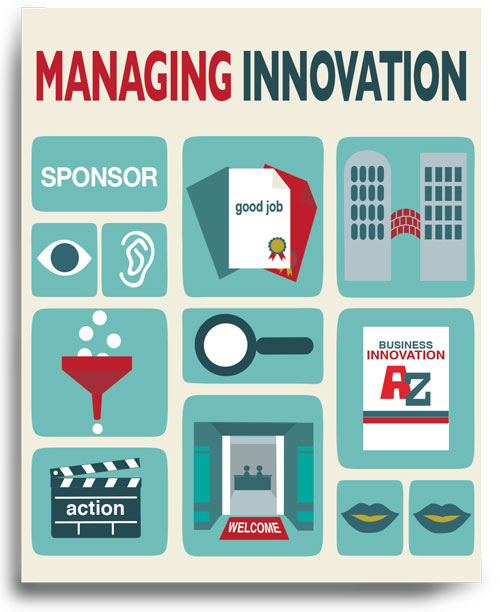By Daniel Evans
At EMLYON we have had the opportunity to help develop the innovation efforts for companies around the world. Our combined experience suggests that there are some key factors that must be considered so that these efforts are effective. These factors are applicable across sectors and types of innovation, and apply equally to both big and small companies.
The 10 factors listed below are based on the strong belief that everyone in the organisation must play an active role in the innovation process. Innovation is not the “private territory” or “chasse gardée” of any particular part of the organization. It is only through the combined efforts of everyone, and in particular efforts conducted across organization boundaries, that innovation will truly succeed.
1. Be Exemplary
Words alone are insufficient. Executives will be judged though their actions. Play or pray!
“Innovation is at the heart of our strategic success – everyone plays a key role in the process.”
Nice words – BUT – if they are just words and not actions, the business leader is not sending the key message to people – innovation requires action.
Leaders of innovative companies need to clearly communicate that innovation is a strategic imperative. This message needs to be preached from the highest level of the organisation. In addition, leaders need to back up these words with actions. They need to accept that their ideas are challenged. They need to show through their actions that failure is more than just “OK” – innovation requires failure.
How many times have you heard your CEO talk openly about his or her own failures?
How often does he or she stimulate critical discussion and conversation?
2. Expose And Respect The Innovation Process
A hidden process opens the door to anything and everything – and closes the door for innovators.
For some bizarre reason, many companies that “promote” innovation insist on keeping secret the criteria used to judge and evaluate innovation projects.
This is, quite frankly, stupid.
The innovation process and path used to help emerge and advance value-adding projects must be totally transparent. Everyone, everywhere should understand such a process exists.
ALL projects should be treated fairly and the process must be respected. If there are always exceptions to the process – change the process. Clearly define the “stage-gates” of assessment and what “off-ramps” or “on-ramps” may exist for projects that may need to go faster or that enter the process later on.
Keep it simple, clear—and above all—respect your process so that the process is respected by the innovators.
3. Facilitate The Process
Make sure that the innovation machine is well oiled and that potential innovators can develop the key competencies required of them.
“We have a budget for cross-divisional innovation projects – but nobody has ever asked for the money!”
The number of companies that say they have a clear process, budgets, and resources, yet nobody takes advantage of them, constantly amazes us. One of the key reasons for this is that the company has not properly “oiled” the innovation machine. Potential innovators are not all marketing geniuses, financial gurus or negotiation supermen.
To facilitate the process, the organization needs to provide practical guides and tools (ex. business planning guides, marketing tips, pro-forma financial worksheets…) that can be easily accessed and used by potential innovators. These different guides and tools can be made available on the company intranet or printed and distributed to all.
In addition, many innovators may need to develop some competencies. The organization needs to encourage learning agility of potential internal entrepreneurs:
– Provide e-learning on finance and marketing that can be used when the project owners need help (just-in-time e-learning)
– Provide coaching for projects
– Provide access to data and market reports via an online full-text database (ex. Proquest, Xerfi, etc.)
– Provide effective training and development solutions that focus on behavioural development (action based learning, on-the-job learning activities, experience based learning…)
4. Recognize Step-By-Step Success
Projects may fail – but make sure the innovators and intrapreneurs do not!
Once the process is in place and intrapreneurs are advancing their projects through a clear evaluation process, each “victory” along the way should be rewarded.
The innovation process is based on a funnel that welcomes a large number of potential innovations and slowly filters out projects that do not meet various clearly identified stage-gate criteria. The key management challenge is to effectively manage projects that don’t make it all the way – which is the vast majority of projects.
Innovators should be rewarded for having advanced their project – no matter how far. The goal is to make sure that the innovator goes down the funnel again. In most cases, innovators/intrap4 reneurs are taking some risk by taking a project down the innovation funnel. If your system does not reward the person for the work accomplished, why would they accept to take this risk again in the future?
Make sure that your organisation clearly distinguishes between the success of the innovator and success of the project. Don’t throw the baby out with the bath water!
5. Start Talking
If you’re talking – you’re thinking. If you’re thinking – you’re creating. If you’re creating – you’re innovating.
Successful innovators encourage open discussion and thinking. According to Coffeeble, the coffee machine becomes a source of inspiration.
One way to make sure this happens is for the business leader to always place a challenge to think about and reflect upon in front of their employees. This is difficult for many as it shows that one does not always have the answers. Get your employees to start meaningful conversations about strategy, your position, your competitors, internal operations, etc…This will act as a “spark” to ignite the process.
6. Build Bridges – Bust Barriers
Encourage – or even require – interdisciplinary and interdivisional work to think “out of the box.”
Imagine – the Sony corporation, founder of the Walkman, was sitting on a huge library of music and yet was unable to beat the Apple iPod to market. Even worse, the Network Walkman project existed inside Sony but was slowed down due to divisional turf wars!
Innovation opportunities are often found in between or across existing organisational structures. Unfortunately, most organisations do not facilitate the emergence of these “spinning” innovations and very few organisations provide a support and resourcing process for them if they do emerge.
To start, the company needs to create opportunities for people to exchange ideas and knowledge across the organization. These opportunities could include social gatherings, joint training programmes, interdivisional projects, interdisciplinary teams, etc.
The organization could also reward cooperative behaviour. For example, it could create an annual award for the best inter-divisional project, facilitate job rotation, etc.
7. Focus On The Customer
Techno-push or demand-pull…who cares? …If the customer won’t adopt the idea then it’s not really an innovation.
All the greatest ideas are worth nothing if the customer thinks they’re worthless! Start listening to the customer and markets, keep your eyes and ears open and proactively seek information about emerging trends.
Some companies we have worked with have gone to great lengths to make sure today’s and tomorrow’s customer was understood. In one case, senior executives were required to spend at least one day in a customer retail or service center. Make sure information is readily available about current trends and PUSH your people to get “in the face” of the client.
In the United States, the CEO of Jet Blue serves in-flight meals to his clients. He takes the opportunity to listen to their needs–directly. These contacts led to multiple service innovations.
Finally, if you believe you are in a pure “product” industry, think again. Studies consistently show that it is the associated service quality that defines the overall quality of your products (hotlines, repairs, etc.).
8. Open-Up
The amount of innovation required of big companies today can’t be done alone. Open up your innovation process.
The amount and scope of innovation required of companies today is pushing more and more companies to open up their innovation process. Inventions can be found just about anywhere today – the key is to convert them into value-adding innovations.
Openness also concerns your own ideas and inventions. In today’s competitive economy, inventors that are rejected by their own company will look elsewhere for recognition. The choice is simple: either you help them sell their ideas and eventually benefit in some way, or they do it themselves, leaving your company and taking their ideas with them.
Open up. Don’t reinvent the wheel. Look outside for potential inventions and create external value out of inventions you can’t use internally.
9. Rigourously Evaluate Managers
If it’s really important then it’s evaluated and rewarded.
Take 10 minutes to look at your management review process. What is being evaluated? What is being rewarded? In many cases, companies are rewarding short-term division centric behaviour, very effectively discouraging managers from looking beyond the tip of their noses.
Start by first identifying behaviours you need your managers to exhibit. Do they sponsor innovation projects? Do they actively share information with other divisions and units? Do they encourage people to pursue innovation opportunities?
Also, you need to focus on behaviours. Again, innovation requires action. Behavioural interviewing needs to be a key point of any annual performance review.
10. Sponsor
Projects need sponsors to succeed. Period.
In many cases, the innovation process is a real maze. Managers should be rewarded in their efforts to sponsor an intrapreneur.
Sponsors play a key role in helping the intrapreneur to:
– Open doors to internal and external resources (financial, human and technical).
– Frame the project to be aligned with key stakeholder concerns.
– Navigate any “red tape” issues.
– Find potential customers inside and outside the organisation.
– Get support from senior executives.
About the Author
Daniel Evens is the Chief Innovation Officer at EML Executive Development. Dan holds a Ph.D. from The Ohio State University in Economics. He started his academic career upon his arrival in France in 1993. He has since been Director of MBA programmes, Head of technology based learning activities and Dean of Executive Education.
Dan has been heavily involved in facilitating the emergence of value in the “fuzzy-front-end” of innovation – helping companies recognize entrepreneurial opportunities. His areas of specialisation include creative thinking, opportunity recognition, Intrapreneurship and leadership applied to services and high-technology sectors.







![Deconstructing the Myth of Entrepreneurship iStock-2151090098 [Converted]](https://www.europeanbusinessreview.com/wp-content/uploads/2024/09/iStock-2151090098-Converted-218x150.png)


























